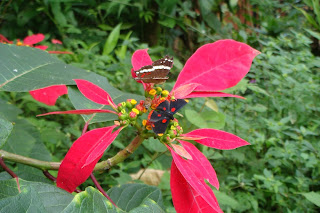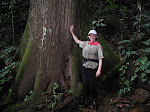skip to main |
skip to sidebar
What is this Caterpillar? Answer: Frangipani Hawk Moth Larva
 Can anyone identify this caterpillar? Thank you Kathryn Kostka de Tanzi and Barry Biesanz and Mark Plotkin for the feedback! This is a Frangipani Hawk Moth Larva called Pseudo sphinx tetrio - a sphinx moth- that loves Plumeria trees - and also Oleander trees. We had about 15 of these colorful creatures living on the Plumeria rubra (Frangipani) trees during most of August. They chomped down on the leaves and soon nearly doubled in size, each caterpillar claiming his own branch, and eventually they ate all the leaves. I need not have worried, the leaves quickly started growing back and no lasting damage was apparent. What would they morph into next? One day I decided to take these pictures. And it’s a good thing I did, because the very next day all the caterpillars were gone. Sometime during the night, they all came down from the Frangipani trees and went somewhere else!
Can anyone identify this caterpillar? Thank you Kathryn Kostka de Tanzi and Barry Biesanz and Mark Plotkin for the feedback! This is a Frangipani Hawk Moth Larva called Pseudo sphinx tetrio - a sphinx moth- that loves Plumeria trees - and also Oleander trees. We had about 15 of these colorful creatures living on the Plumeria rubra (Frangipani) trees during most of August. They chomped down on the leaves and soon nearly doubled in size, each caterpillar claiming his own branch, and eventually they ate all the leaves. I need not have worried, the leaves quickly started growing back and no lasting damage was apparent. What would they morph into next? One day I decided to take these pictures. And it’s a good thing I did, because the very next day all the caterpillars were gone. Sometime during the night, they all came down from the Frangipani trees and went somewhere else! 
 Actually, right now is high season for butterflies in the El Rodeo forest; there is an astounding variety of them, which would dazzle any collector, or even any non-collector for that matter. And there is much to learn from them. Our neighbor has even observed moths that mimic wasps. Nature never fails to astonish and fascinate, offering lessons to those who want to observe and study it, and producing a state of wonder for those who just want to walk within it.
Actually, right now is high season for butterflies in the El Rodeo forest; there is an astounding variety of them, which would dazzle any collector, or even any non-collector for that matter. And there is much to learn from them. Our neighbor has even observed moths that mimic wasps. Nature never fails to astonish and fascinate, offering lessons to those who want to observe and study it, and producing a state of wonder for those who just want to walk within it. So what’s this big white bird running about with our hens? We now have a turkey out at the stable! Until recently it belonged to a neighbor, who bought a pair of them with the idea to breed them. But her dog had a different idea… That big bird was just too tempting. So, after the female became Thanksgiving doggie-dinner, she asked us to adopt the male, and he has adapted surprisingly well. He seems to get on with the hens – he doesn’t bully them and they don’t peck him.
So what’s this big white bird running about with our hens? We now have a turkey out at the stable! Until recently it belonged to a neighbor, who bought a pair of them with the idea to breed them. But her dog had a different idea… That big bird was just too tempting. So, after the female became Thanksgiving doggie-dinner, she asked us to adopt the male, and he has adapted surprisingly well. He seems to get on with the hens – he doesn’t bully them and they don’t peck him.  He’s a gentle giant in a hen house where, yes indeed, there is a pecking order… We let them out into their garden during the day but they all go back inside at night, along with the turkey. We have learned that the forest can very easily make quick meals out of ‘free-range’ hens. But Jose has accomplished the next to impossible – he has created conditions so that the hens can thrive in a ‘free-range’environment yet survive. We breed criollo hens for their eggs. Criollos, like all natives, can resist illnesses and are adapted to the tropical climate – and they produce incredibly delicious eggs with very bright yellow yolks!
He’s a gentle giant in a hen house where, yes indeed, there is a pecking order… We let them out into their garden during the day but they all go back inside at night, along with the turkey. We have learned that the forest can very easily make quick meals out of ‘free-range’ hens. But Jose has accomplished the next to impossible – he has created conditions so that the hens can thrive in a ‘free-range’environment yet survive. We breed criollo hens for their eggs. Criollos, like all natives, can resist illnesses and are adapted to the tropical climate – and they produce incredibly delicious eggs with very bright yellow yolks!
 Can anyone identify this caterpillar? Thank you Kathryn Kostka de Tanzi and Barry Biesanz and Mark Plotkin for the feedback! This is a Frangipani Hawk Moth Larva called Pseudo sphinx tetrio - a sphinx moth- that loves Plumeria trees - and also Oleander trees. We had about 15 of these colorful creatures living on the Plumeria rubra (Frangipani) trees during most of August. They chomped down on the leaves and soon nearly doubled in size, each caterpillar claiming his own branch, and eventually they ate all the leaves. I need not have worried, the leaves quickly started growing back and no lasting damage was apparent. What would they morph into next? One day I decided to take these pictures. And it’s a good thing I did, because the very next day all the caterpillars were gone. Sometime during the night, they all came down from the Frangipani trees and went somewhere else!
Can anyone identify this caterpillar? Thank you Kathryn Kostka de Tanzi and Barry Biesanz and Mark Plotkin for the feedback! This is a Frangipani Hawk Moth Larva called Pseudo sphinx tetrio - a sphinx moth- that loves Plumeria trees - and also Oleander trees. We had about 15 of these colorful creatures living on the Plumeria rubra (Frangipani) trees during most of August. They chomped down on the leaves and soon nearly doubled in size, each caterpillar claiming his own branch, and eventually they ate all the leaves. I need not have worried, the leaves quickly started growing back and no lasting damage was apparent. What would they morph into next? One day I decided to take these pictures. And it’s a good thing I did, because the very next day all the caterpillars were gone. Sometime during the night, they all came down from the Frangipani trees and went somewhere else!  Actually, right now is high season for butterflies in the El Rodeo forest; there is an astounding variety of them, which would dazzle any collector, or even any non-collector for that matter. And there is much to learn from them. Our neighbor has even observed moths that mimic wasps. Nature never fails to astonish and fascinate, offering lessons to those who want to observe and study it, and producing a state of wonder for those who just want to walk within it.
Actually, right now is high season for butterflies in the El Rodeo forest; there is an astounding variety of them, which would dazzle any collector, or even any non-collector for that matter. And there is much to learn from them. Our neighbor has even observed moths that mimic wasps. Nature never fails to astonish and fascinate, offering lessons to those who want to observe and study it, and producing a state of wonder for those who just want to walk within it. So what’s this big white bird running about with our hens? We now have a turkey out at the stable! Until recently it belonged to a neighbor, who bought a pair of them with the idea to breed them. But her dog had a different idea… That big bird was just too tempting. So, after the female became Thanksgiving doggie-dinner, she asked us to adopt the male, and he has adapted surprisingly well. He seems to get on with the hens – he doesn’t bully them and they don’t peck him.
So what’s this big white bird running about with our hens? We now have a turkey out at the stable! Until recently it belonged to a neighbor, who bought a pair of them with the idea to breed them. But her dog had a different idea… That big bird was just too tempting. So, after the female became Thanksgiving doggie-dinner, she asked us to adopt the male, and he has adapted surprisingly well. He seems to get on with the hens – he doesn’t bully them and they don’t peck him.  He’s a gentle giant in a hen house where, yes indeed, there is a pecking order… We let them out into their garden during the day but they all go back inside at night, along with the turkey. We have learned that the forest can very easily make quick meals out of ‘free-range’ hens. But Jose has accomplished the next to impossible – he has created conditions so that the hens can thrive in a ‘free-range’environment yet survive. We breed criollo hens for their eggs. Criollos, like all natives, can resist illnesses and are adapted to the tropical climate – and they produce incredibly delicious eggs with very bright yellow yolks!
He’s a gentle giant in a hen house where, yes indeed, there is a pecking order… We let them out into their garden during the day but they all go back inside at night, along with the turkey. We have learned that the forest can very easily make quick meals out of ‘free-range’ hens. But Jose has accomplished the next to impossible – he has created conditions so that the hens can thrive in a ‘free-range’environment yet survive. We breed criollo hens for their eggs. Criollos, like all natives, can resist illnesses and are adapted to the tropical climate – and they produce incredibly delicious eggs with very bright yellow yolks! 


1 comment:
Quisiera saber si la larva de polilla halcón frangipani o seudo tetrix caterpillar pica o es venenosa al contacto con la piel?
Post a Comment